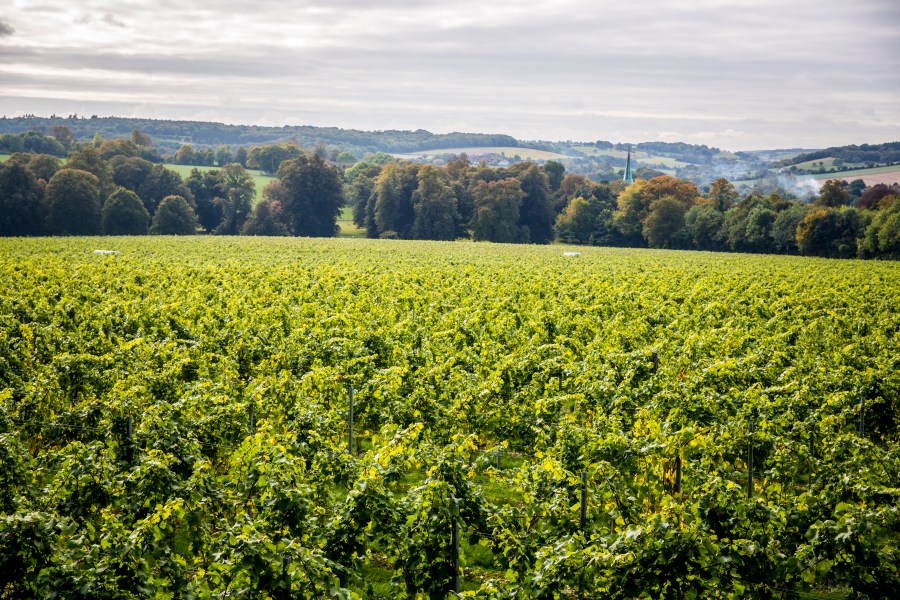After purchasing two plots of arable land on the outskirts of Barham, Kent, in 2013, this year was the third harvest for Simpsons Wine Estate’s Roman Road vineyard and the first harvest for half of its Railway Hill site.
From the two 10-hectare blocks, which are planted with Chardonnay, Pinot noir and Pinot meunier, as of 1 November 2018 the estate had hauled in an enormous 200 tonnes; and with some fruit still left on the vines at that point, it is an eye watering comparison to the 30 tonnes which were picked last year.
“It has been an incredible first harvest for the block at Railway Hill which was planted in 2016,” said Ruth Simpson, owner of Simpsons Wine Estate. “The Roman Road vineyard too has been cropping at exponential rates and we can’t get over it. Naturally, we are delighted because last year we lost 60% of our crop to frost. I believe that the pent-up energy from that, combined with the ideal growing season this year, has led to a crop which is about 10 times bigger than we expected.”
Bumper harvests may make for happy vineyard owners, but back in the wineries across the country there has been a lot of mixed emotions over just where to put all this fruit. While some already had more tanks on order, with crops seemingly exceeding many estimations, this season has seen many wineries going to great lengths, from borrowing stainless steel vessels from neighbouring breweries, to bringing in tankers, to ensure that there was sufficient capacity.
Scavenging for tanks
For Ruth and husband Charles, plans to expand the winery in early 2019 had already been put into motion, with a round of East Kent LEADER grant funding under the Rural Developments Programme for England (RDPE) having been secured for the constructing of an additional building and investment into a second press and more tanks.
As soon as the grant offer was received, the couple got in touch with the administrators to explain how big this year’s harvest was looking and were able to advance part of the funding to see four 100-hectolitre tanks safely delivered before the start of picking.
However, this additional space still wasn’t sufficient, and as the company they had been working with, Bevtech, had already been inundated with tank requests there was simply nothing left available on the UK market.
Luckily, the couple, who also own Domaine Sainte Rose in the Languedoc, were able to call in some favours from their French suppliers.
“As we started picking and realised what the figures were really looking like, we had to start scavenging tanks from elsewhere,” said Ruth. “In total, we will have taken delivery of 12 new tanks this year and I don’t think we could have got them without our French connections.”
To cope with the abundance of fruit, Simpsons were also in need of an additional press, and while they are set to purchase a second Inertys press from Bucher Vaslin next year, this year they were fortunately able to borrow a conventional press from the manufacturer.
“We press under nitrogen as much as we possibly can,” said Ruth. “However, borrowing the second press this year meant that we did one press through the Inertys system and then one or two non-inert pressings per day. Ultimately, it will give us more flexibility, a broader flavour spectrum and will increase our options when it comes to blending.”
Bringing it to life
Once at full production Simpsons Wine Estate will be producing around 250,000 to 300,000 bottles per year and while the team just about managed to cram everything into the existing space this year, local builder A R Davies is set to start work on the winery extension in the new year.
“We purchased two barns from the farmer who sold us the land,” said Ruth. “They were ideally located between the two vineyards and we have been busy converting them over the years. The first barn is for wine storage, bottling, riddling and labelling facilities and the second for winemaking. Ultimately, we will run out of space, so the next stage of the development will see the construction of a separate room for our two presses.”
Tourism was also at the forefront of the winery conversion and A R Davis were appointed to construct a bespoke steel mezzanine structure to provide much needed office space for the growing team, as well as a unique cellar door facility overlooking the winery.
“We decided to make full use of the height of the building with glass panels which would allow visitors to see where the wine is made,” said Ruth. “We were joking about having a fireman’s pole down into the winery and suddenly we ended up with a helter skelter. It is an unnecessary item, but it is very memorable. Of course, the wines will always be the most important factor, but if visitors end their tasting by coming down the “fruit chute” and they leave with a smile on their face, it brings it all to life. Wine tourism is becoming an increasingly important factor for us, especially now the Wine Garden of England initiative has been launched and we want to be able to do it at a very high level.”
To read the full article see the online edition of the magazine.




